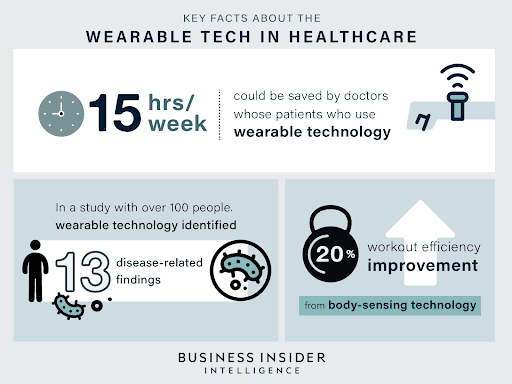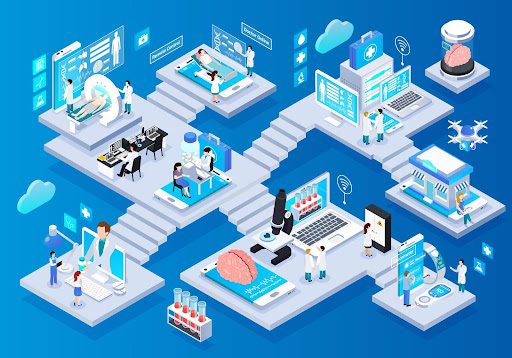
Covid 19 pandemic has brought a new wave in the healthcare industry, and they have brought a giant leap forward in the digital healthcare roadmap. According to healthcare stats, telemedicine can reach $186.5bn by 2026, and it saves patients over 100 minutes more than their in-person visit.
Today 85% of patients feel satisfied with telemedicine services. The healthcare industry has changed dramatically in the last decade, shifting from traditional medicine to virtual health. More and more people have started leveraging technology, and it is only natural that providers adopt new ways of delivering care.
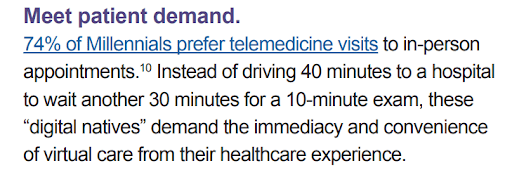
This blog post will cover virtual health and how it can improve your healthcare experience in the coming years. So, let’s get started.
The Future of Virtual Healthcare Industry:
1. Artificial and Augmented Reality- The Perfect Transformation Booster
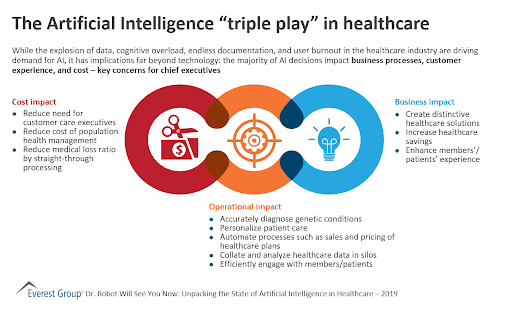
Artificial intelligence (AI) is an area of computer science focused on creating machines that can perform tasks similar to humans.
Augmented reality (AR) refers to the direct or indirect view of a physical, real-world environment whose elements are augmented by virtual information.
Both AI and AR have become practical tools for the healthcare industry to improve patient outcomes tremendously.
We can use AI and AR in many different ways, such as:
-Surgeries performed remotely by highly skilled surgeons located across the world via telehealth sessions
-Patients that are bedridden or require assistance from nurses at home have access to virtual health assistants like Siri or Alexa
Doctors can view a patient’s vital signs from across the room instead of having their eyes glued over a screen all day long.
There are endless possibilities for using AI and AR in healthcare, but one thing is confirmed – these technologies will dramatically change how we experience health care as humans.
In the future, we will be using these technologies to improve our health and wellbeing. So, start planning for your future today and hire app development companies in India, and they will prepare you better for the future.
2. Home-Based Care-A New Norm
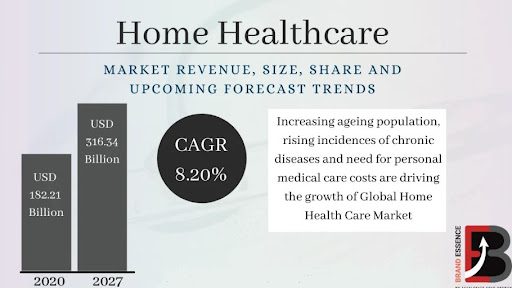
The future of healthcare is a place where you can receive care from anywhere.
Home-based care will quickly become the new norm as providers begin to embrace virtual health and employ remote employees patient monitoring tools that allow patients to check in with their doctors from home for symptoms, medication refills, lab results, etc.
With technology growing exponentially, these tools will be available on our cell phones and virtual assistants in our everyday lives. We already see the early stages with telehealth clinics located across more than half of US states allowing patients to communicate with their doctor through live video sessions. At the same time, home monitoring devices like FitBit can track your activity levels 24/hrs a day and send data to your doctor.
It is good news for everyone since we could all use a little more time in our day. With these trends, your doctor visit will look very different from today, with extended hours and even weekend appointments for patients who work weekdays.
3. Wearables-A Modern Healthcare Fashion Accessory
Today, we are at the early stages of a wearable revolution. With Apple, FitBit, Garmin, and Samsung all competing for market share, it’s only natural that healthcare follows suit with products like smartwatches designed to monitor your heart rate or blood pressure throughout the day.
Wearable technology will revolutionize how providers deliver care in several ways-
-First, monitoring your vitals will allow doctors to track patient progress and intervene early when health issues arise.
-Second, the ability to monitor people’s activity levels from their wrist 24/hrs a day can help drive better behavior change for patients at high risk for chronic conditions like diabetes or heart disease.
Finally, wearable technology can help drive operational efficiency for providers by allowing them to track their employees’ productivity levels and make changes accordingly, which is complex with traditional measuring performance in the workplace.
Wearable technology will transform how we approach health care because it’s something everyone has access to daily. Whether working anywhere, either office or at home, your wearable will become a fashion accessory that seamlessly integrates into our everyday lives.
Over time this technology will be accessible to everyone since it is already being incorporated into devices like smartwatches and glasses, allowing us to use these tools without having a prominent device strapped around our wrist or head.
The future of virtual healthcare will be where wearable technology is considered the norm, and patients can easily monitor their vitals at home or in the office.
It allows providers to extend hours, reduce costs, and improve patient quality outcomes while increasing employee productivity, leading to better care delivery across the board.
4. Two-Way Video to Drive Operational Efficiency
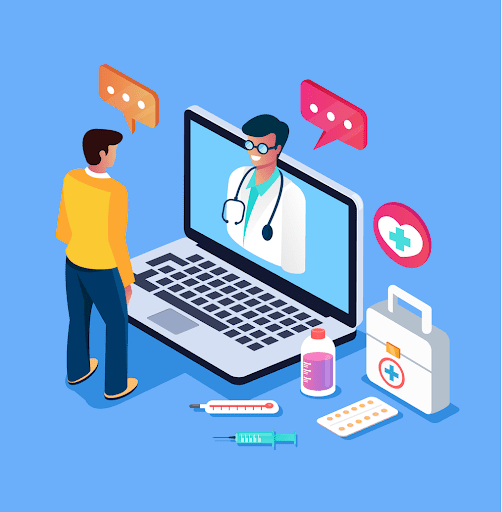
The two-way video has been around for a while, but it’s starting to become the norm in healthcare facilities across America. This technology can transform how providers deliver care by monitoring their patients remotely and providing better services for people at home.
In fact, according to a VSee Lab Inc. survey, there is already widespread adoption of two-way video, with 39% using this technology on an ongoing basis and 23% planning to implement it during 2018.
For example, you can use two-way video in patient monitoring devices like blood pressure cuffs or weight scales where nurses could look at data sent from these tools while speaking with patients over the internet.
It can help ensure better care because it gives nurses and doctors access to more information than ever before, allowing them to intervene earlier when necessary.
This technology can also allow providers to monitor patients remotely to identify health trends early on before an issue becomes serious, which will help drive better patient outcomes in the future.
While two-way video has been around for a while, it’s only now gaining momentum among healthcare professionals nationwide because it provides a better way to provide care in the future.
Conclusion
The future of healthcare is looking more and more virtual. With artificial intelligence, augmented intelligence, home-based care, wearables for health monitoring, and two-way video to drive operational efficiency being top trends in the industry, there are plenty of ways that technology will continue to transform healthcare as we know it.
If you’re interested and want to grow your current business with some new tech, contact a healthcare software development company in India. They offer a wide range of services, from custom software development to consulting on how best to use these developments for increased ROI.
FAQs
Q- What is virtual health?
A- Virtual health allows patients to see their primary care providers or specialists virtually, saving time and money in low-risk situations when simple lifestyle changes are enough to improve patient outcomes. Virtual visits also give people access to the best medical care in America without leaving their homes, which creates an entirely new way of receiving healthcare.
Q- What are some examples of wearable technology that can help drive better health outcomes?
A- Some popular devices include smartwatches, glasses, and fitness trackers. These tools give patients access to their vitals anywhere at any time, allowing them to monitor things like heart rate 24/hrs a day which is helpful for people with chronic conditions.
Q- How does two-way video improve healthcare?
A- The technology allows nurses and doctors to interact with their patients differently since they can do this over the internet through wearable devices like smartwatches or glasses. It also gives providers access to more information than ever before, and it has the potential to transform how they deliver care. It allows them to focus on a patient’s needs instead of turning their back, which can help improve quality outcomes since providers can intervene early when necessary.
Q- How is virtual health changing healthcare?
A- Virtual health works by allowing people to connect with doctors and nurses through the internet. This technology is becoming more prevalent as health professionals begin to see its benefits, including extended hours, reduced costs, improved patient quality outcomes, and increased employee productivity levels. It has already transformed how hospitals operate by helping them grow their hours while also reducing costs to better focus on patient benefits.
Q- How can virtual health impact patient outcomes in the future?
A- Virtual health makes it easier for patients to connect with healthcare professionals, giving providers access to more information than ever before. This technology enables nurses and doctors to interact with their patients through wearable devices or smartwatches, which can help drive better care since they can monitor things like heart rate 24/hrs a day remotely.
Q- What are some benefits of two-way video technology?
A- Some of the benefits include being able to extend hours, reduce costs, improve quality outcomes for patients, and increase employee productivity levels which are all things that will help drive better patient care in the future.

